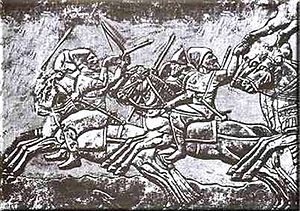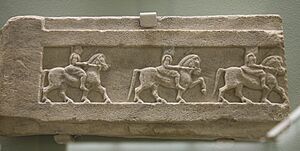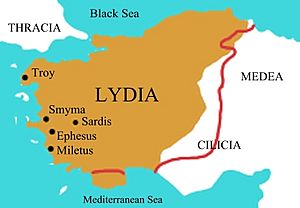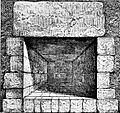Alyattes facts for kids
Quick facts for kids Alyattes |
|
|---|---|
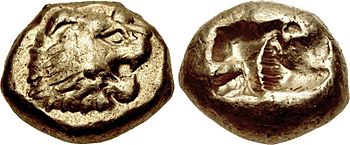
Coin of Alyattes. Circa 620/10-564/53 BC.
|
|
| King of Lydia | |
| Reign | c. 635 – c. 585 BC |
| Predecessor | Sadyattes |
| Successor | Croesus |
| Died | 585 BCE Sardis |
| Burial | 585 BCE Plain of Sardis (now Bin Tepe) |
| Issue | Aryenis Croesus Pantaleon |
| Lydian | 𐤥𐤠𐤩𐤥𐤤𐤯𐤤𐤮 (Walweteś) |
| Dynasty | Mermnad dynasty |
| Father | Sadyattes |
| Mother | Lyde |
Alyattes (reigned around 635-585 BC) was a powerful king of Lydia, an ancient kingdom in what is now Turkey. He was the fourth king of the Mermnad dynasty. Alyattes was the son of King Sadyattes and the grandson of Ardys.
He ruled for 57 years and was followed by his famous son, Croesus. Alyattes is known for being the first ruler to issue coins made from electrum. This was a natural mix of gold and silver. His son Croesus later created the first pure gold coins. Because of this, Alyattes is often seen as the inventor of coinage.
Contents
What's in a Name?
The name Alyattes comes from the Lydian word Walweteś. This name meant "lion-ness" or "the state of being a lion." It combined the Lydian word walwe, meaning "lion," with a special ending.
When Did He Rule?
The exact dates for the Mermnad kings are a bit unclear. Historians have used different sources to figure them out. Based on records from the Assyrians, historians believe Alyattes's reign started around 635 BCE. He ruled until 585 BCE. His son Croesus then took over in 560 BCE.
Life as King
Alyattes became king during a very difficult time for Lydia. His kingdom had been attacked many times by the Cimmerians. These were nomadic people from the Eurasian Steppe. They had even sacked Lydia's capital, Sardis, twice. Alyattes's father and grandfather had struggled against them. So, Alyattes took the throne in 635 BCE with many challenges to face.
Early Dealings with Greek Cities
Alyattes began his rule by continuing a war with the Greek city of Miletus. This war was mainly about getting grain, which Lydia needed. After about six years, around 630 BCE, Alyattes made peace with Miletus. They signed a friendship treaty and a military alliance. Lydia traded its metals for Miletus's grain. Miletus also helped Lydia with soldiers. This gave Lydia access to important trade routes.
Alyattes kept good relations with the Greek city of Ephesus. The royal families of Lydia and Ephesus were connected by marriage. Because of these ties, Ephesus was never attacked by Lydia. It also did not have to pay tribute or send soldiers. Ephesus became an important port for Lydia. It connected Lydia to the Mediterranean Sea and other trade routes.
Gifts to the Oracle of Delphi
Like his great-grandfather, Alyattes gave many gifts to the oracle of the god Apollo at Delphi. These gifts included a large silver bowl and an iron stand. These gifts showed off Lydia's wealth and art. They also helped Alyattes gain favor with the Greeks. He hoped the oracle would help him make peace with Miletus.
Alliances with Caria
In the south, Alyattes continued to make alliances with the city-states of the Carians. Lydians and Carians shared cultural ties. They even shared a temple for the god Zeus. To make these alliances stronger, Alyattes married a woman from the Carian noble family. Their son, Croesus, would later become king. These alliances helped Lydia control the region of Caria.
Defeating the Cimmerians
Alyattes had inherited wars from his father. Soon after he became king, he teamed up with the Scythians. The Scythians were another nomadic group. Their king, Madyes, helped Alyattes. Together, they finally defeated the Cimmerians. The Cimmerians were no longer a threat to Lydia. This big victory happened around 600 BCE.
Some stories say Alyattes used "war dogs" to defeat the Cimmerians. This likely meant young Scythian warriors. These warriors would act like wolf or dog fighters as part of their traditions. After this victory, Alyattes drove out the last Cimmerians from a city called Antandrus. He also rebuilt Adramyttium and made his son Croesus its governor. This city was important because it was near rich mines.
Expanding Eastward
After defeating the Cimmerians, Alyattes expanded his kingdom to the east. He moved into Phrygia, a region that had been weakened by the Cimmerian raids. Lydia had friendly ties with Phrygia before. Alyattes used this to extend Lydian rule. We know Lydians were in Phrygia from old buildings and artifacts. For example, a Lydian fort was found in the Phrygian capital of Gordion.
Phrygia kept its local rulers, but they had to obey the Lydian king. They had to provide military support and sometimes tribute. This helped protect Lydia from attacks from the east. Alyattes's kingdom grew to include many peoples west of the Halys River.
Later Wars with Greek Cities
Around 600 BCE, Alyattes started fighting again in the west. He attacked the Greek city of Smyrna. Lydia had good relations with Smyrna before. Smyrna was important because it had a port. This port gave Lydia access to the sea and a steady supply of grain. Smyrna came under Lydian rule. Alyattes built new walls for the city.
Alyattes also had a military alliance with Colophon. Colophon had famous cavalry (horse soldiers). But when Alyattes attacked Clazomenae, Colophon helped Clazomenae. Alyattes was defeated. Later, Alyattes tricked the Colophonian cavalry. He had them killed and took their horses. Then he took control of Colophon. The reason for this betrayal is not fully known.
War Against the Medes
Alyattes's expansion in the east led to a conflict with the Medes. The Medes were a powerful Iranian people. They had helped destroy the Neo-Assyrian Empire. A war broke out between Lydia and the Medes in 590 BCE. It lasted for five years.
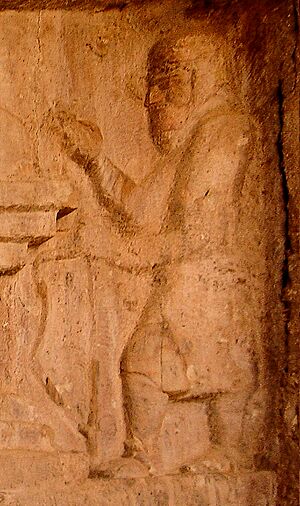
During a battle in 585 BCE, a solar eclipse happened. Both sides saw this as a sign to end the war. The kings of Babylon and Cilicia helped make a peace treaty. To seal the peace, Alyattes's daughter, Aryenis, married the Median king's son, Astyages. The border between the two empires was set in eastern Anatolia.
Alyattes and Coins
Alyattes is famous for creating the first coins in history. These coins were made from electrum. This is a natural mix of gold and silver. Before coins, people had to weigh precious metals for every trade. Alyattes's coins had a special mark. This mark showed who issued the coin and guaranteed its value. This made trading much easier.
Today, we still use coins where the government guarantees the value. Alyattes's invention spread to the Greeks. He set a standard weight for his coins. They were made using a special stamping method. Each coin had a lion's head, which was the symbol of his royal family.
His Tomb

Alyattes died in 585 BCE, shortly after the war with the Medes ended. His tomb is still standing today near Sardis. It is a huge mound of earth called a tumulus. It is sixty meters (about 200 feet) high and two hundred and fifty meters (about 820 feet) wide. It is one of the largest tombs ever built.
The tomb has an entrance hall and a main chamber. It was built with large, well-fitted marble blocks. When it was explored, it had already been robbed. Only some broken vases and pottery were left. Before it was plundered, the tomb likely held many treasures. These would have included furniture, jewelry, and gold and silver bowls.
Some historians think that Buddhist stupas (mound-like structures) might have been inspired by similar ancient tombs. These include the tomb of Alyattes.
Images for kids
See also
 In Spanish: Aliates para niños
In Spanish: Aliates para niños



